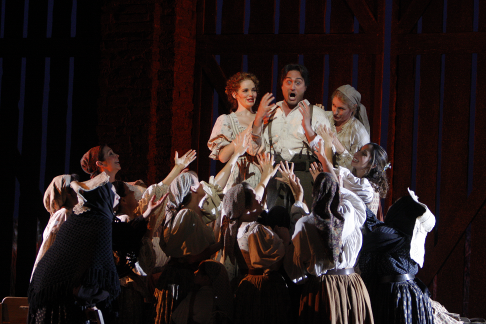02 Mar 2014
San Diego Opera’s Elixir of Love
On Sunday afternoon, February 23, 2014, San Diego Opera presented The Elixir of Love in a traditional production by Stephen Lawless.

On Sunday afternoon, February 23, 2014, San Diego Opera presented The Elixir of Love in a traditional production by Stephen Lawless.
He told the story in an easily understandable manner and gave the singers a great deal of comedy that kept the action moving forward.
Gaetano Donizetti often wrote his operas in an amazingly short time. He and librettist Felice Romani wrote L’elisir d’amore (The Elixir of Love) in six weeks, using a translation of Eugène Scribe’s libretto for Daniel Auber’s Le Philtre, (The Potion) as a model. They made the Italian opera more romantic than its French relative with the introduction of what is now the best-known aria in the piece, “Una Furtiva Lagrima”, and the addition of a duet for Adina and Nemorino in Act I.
Donizetti must have felt a personal relationship with the character of Nemorino because a wealthy lady had once bought him out of an army contract. The opera’s premiere at the Teatro della Canobbiana in Milan on May 12, 1832, was a tremendous success and L’Elisir became the most often performed opera in Italy between 1838 and 1848. According to Operabase, it is still one of the world’s most frequently performed operas.
On Sunday afternoon, February 23, 2014, San Diego Opera presented The Elixir of Love in a traditional production by Stephen Lawless that had also been seen in Geneva and Los Angeles. He told the story in an easily understandable manner and gave the singers a great deal of comedy that kept the action moving forward. Johan Engels’ set showed the inside of a large barn with many doors that open up onto farmland growing hay and flowers. Thus, most of the action took place in the barn at the front of the stage. Engels’ artfully detailed costumes set the action firmly in the nineteenth century.
 Giuseppe Filianoti as Nemorino with chorus
Giuseppe Filianoti as Nemorino with chorus
As Nemorino, Giuseppe Filianoti was a lovable, totally unsophisticated country boy who gets into some thoroughly amusing slapstick situations. He looked adorable and proved to be a fine actor, but at this performance his intonation was a serious problem. The Adina, Tatiana Lisnic had no such drawbacks. She hit all the notes correctly while giving a passionate portrayal of the young, attractive landowner. Remember her name. She is a fine talent from whom more great performances can be expected. I hope she will soon again sing in California.
This edition of the score gave Adina’s friend Giannetta more music than usual to sing and Stephanie Weiss sang it to good advantage. Malcolm MacKenzie has a powerful baritone voice with distinctive colors and it underscored his amusing portrayal of the strutting, self-important Sergeant Belcore. Kevin Burdette was a rather different Dr. Dulcamara. Instead of the usual portly basso buffo, this patent medicine salesman was tall, lean, and always ready to run away when someone started to uncover his larcenous ways. He sang with robust tones and his fast patter was a joy to hear.
Charles Prestinari’s chorus sang with delightful harmonies as they moved in small groups to give the impression of farmers, soldiers and townspeople. American conductor Karen Kamensek, music director of Staatsoper Hanover, is a powerhouse on the podium. She opened with brisk tempi and kept the performance moving. The comedy never lagged but the singers always had the leeway they needed to be at their best. She is a fine addition to San Diego Opera and I hope they will have her back soon. Although this was not a perfect performance, it was a a good one that kept the audience interested and amused for a wonderful Sunday afternoon.
Maria Nockin
Cast and production information:
Gianetta, Stephanie Weiss; Nemorino, Giuseppe Filianoti; Adina, Tatiana Lisnic; Sergeant Belcore, Malcolm MacKenzie; Dr. Dulcamara, Kevin Burdette; Conductor, Karen Kamensek; Director, Stephen Lawless; Set and Costume Design, Johan Engels; Lighting Design, Joan /sulliven-Genthe; Chorus Master Charles F. Prestinari.